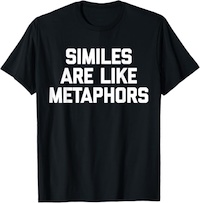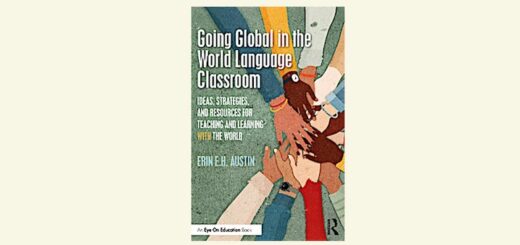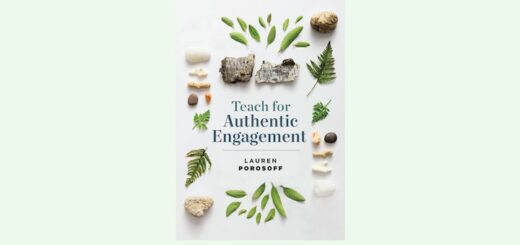2 Questions Help Move Kids Deeper into Texts
By Jason DeHart

While questions about literature can focus on identification, I hope to expand my students’ thinking beyond matching words and examples. This is far from easy, but it is well worth doing. It does require modeling, patience, and multiple opportunities for students to explore and process text throughout a school year.
To launch my students’ deeper exploration this school year, I’ll employ a fairly simple strategy that I began developing this past year. It revolves around two key questions: What’s that? and What’s that doing there?
What’s That?
It’s a fairly friendly question to offer, and I like to find examples that can lead to more than one answer. Questions like “what do you notice” and “what do you wonder” have been singled out for their utility for creating low-stakes discussions. When I want to challenge my students without grandiose language, a question like “what’s that” can offer a relatively open, yet directed, type of questioning. This question also helps me get to identification and is not my stopping point.

I am not saying there is no value in naming the element of literature or figurative language being used – I am just suggesting that students need more. I am always looking to expand beyond rote and match-up when possible. It is my hope that my students become more critical thinkers and that what we explore in literature actually supports them in creating their own.
So, step one is to fold a piece of paper in half. I do embrace digital text, but my students seem to enjoy the balance of “hand to paper” and navigating screens. Often when using this strategy, students are already reading the text on their laptops. Plus, there are times in the year when laptops are not accessible.
On one side of the paper, students write the heading: What’s That? As we read, they jot down a few of the literary features they notice. I am not sure what it is about threes and fives, but I often ask for about this many items as we read a given passage. I also usually chunk passages, even when I’m teaching accomplished readers, so that we can slow down and savor the text for deeper analysis. I believe in giving yourself and your students permission to process, discuss, and explore.
After we identify a few examples, the real fun begins.
What’s That Doing There?
I offer a second friendly question. If there is an element that appears on a page, I want to emphasize to my students that it was put there for a reason of some kind. This is not a perfect system to practice with but, again, it’s well worth it in terms of analysis.
Let’s listen to a quick snippet of lesson dialogue:
“Why do you think the author did that?” teacher says.
“Because they were bored,” student says.
“Maybe. But what if they had other intentions? Why would you include an metaphor like this instead of just telling your audience what is happening in direct terms?” teacher says.
This is the sound of teachers working with real students to stretch their thinking. Expanding conversation about why authors do what they do means getting beyond their boredom and pushing students to start thinking about authorial intent, how writers connect with audiences, and the ways that writing can come alive.
Why does John Steinbeck begin each section with a naturalistic image? What mood is he trying to create? Why does Jason Reynolds arrange poetry in the shape of a question mark? What is the metaphor of the elevator all about? It’s there for a reason, just like that moment in your favorite film or television series, just like that riff in your favorite song.
Linking texts together like this is also a friendly way to help students realize that what we are doing in the work of noticing and naming what authors do (again, with directed purpose) is really something we do at some level anytime we engage thoughtfully with a text of any kind – be it a show, a song, a game, a novel.
From here, further critical questions can help students think about the stories they want to share, including the author moves they want to adopt and make their own. Sometimes metaphors are the only ways to process ideas in life that we do not fully understand, and sometimes the bones of words simply are not enough to communicate what we fully intend.
More Questions We’ll Explore This Year
While my recent series of posts here at MiddleWeb focused on using literacy approaches with digital texts and other forms of reading and composing, this new series is focusing on the essential close work of literacy with middle school students.
Here are a few questions that teachers can reflect on as they think about the role that texts play in their classrooms:
- What kinds of questions am I asking my students?
- Where do I spend most of my time in a text?
- I know it’s good practice, but do I set a purpose at the beginning of reading? In other words, am I just reading something with students because I like it or because it’s the next item on my curricular list – or is there a larger purpose there that I can share with students to build buy-in?
- How can I make reading friendly, open, and a relatively low-stakes process – while also asking students to challenge themselves?
We’ll explore these questions and others in future articles this school year.
Dr. Jason D. DeHart teaches English at Wilkes Central High School in Wilkesboro, North Carolina. He taught English Language Arts to middle grades students in Cleveland, Tennessee for eight years, earned his doctorate, and served as an assistant professor of reading education at Appalachian State University before returning to his first love, the secondary classroom.
Jason’s work has appeared in Edutopia, SIGNAL Journal, English Journal, The Social Studies, and the NCTE Blog. See all of Jason’s MiddleWeb posts here – including a 3-part series with teacher and school librarian Jennifer Sniadecki on using picture books with middle level readers. His website Book Love: Dr. J. Reads offers book reviews and author interviews.



































